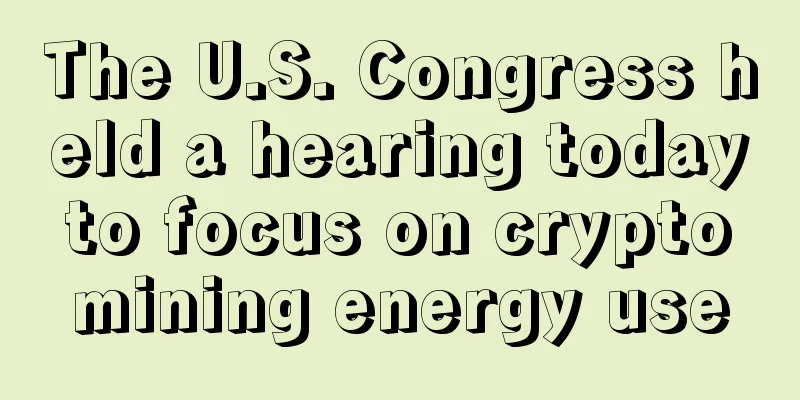The U.S. Congress held a hearing today to focus on crypto mining energy use

|
At 10:30 a.m. EST on Thursday, the U.S. House Energy and Commerce Committee held a hearing to discuss the environmental impact of crypto mining. The Oversight and Investigations Subcommittee asked five witnesses questions about the Proof of Work consensus mechanism, how crypto networks are powered, and what tools or solutions exist to mitigate environmental impacts. The hearing comes a day after Politico affiliate E&E News revealed that the U.S. Environmental Protection Agency had blocked two coal-fired power plants that primarily mine bitcoin from continuing to operate coal ash ponds, saying they create a “toxic slurry.” Cornell Tech professor Ari Juels, Soluna Computing CEO John Belizaire, BitFury CEO Brian Brooks, former Chelan County Utility District General Manager Steven Wright and Jordan Ramis shareholder Gregory Zerzan shared a range of thoughts at the hearing, including support for the proof-of-stake consensus mechanism and questions about the energy mix that powers cryptocurrencies. Rep. Darren Soto asked Professor Juels how data oracles, which connect blockchain data with off-chain systems, can help make mining more efficient. “The problem with blockchains is that they lack direct internet connectivity for a variety of technical reasons,” Juels said. “It’s not possible for a smart contract to visit and query a website the way you and I can. The purpose of an oracle is to provide data to smart contracts so that they can access data from the web. Essentially, what an oracle does is connect the blockchain to off-chain systems, web servers, other blockchains, and so on. So you can think of an oracle as the eyes and ears of a smart contract or blockchain.” Steve Wright said that large data center operators such as Microsoft and Google are more interested in understanding the impact on local utility systems and customers than crypto mining operators. In response to a question from Rep. Lori Trahan about the viability of proof-of-stake mining, Professor Juels said that both proof-of-stake and proof-of-work are viable options for cryptocurrencies and that centralization is a systemic problem related to network dynamics that can affect both types of systems. Professor Juels refuted the claim that crypto mining machines are becoming more efficient. Mining machines are not like light bulbs in our houses. More efficiency means less electricity. So, to be clear, individual mining equipment is becoming more energy efficient. This can be seen in the data on overall energy consumption, which has been growing over time, especially in the past year. Rep. Neal Dunn (R-Va.) said the best way to eliminate the environmental impact of mining is to bring it to the United States and away from countries like China and Kazakhstan. Rep. Ann McLane Kuster (D-Va.) said while there are bad actors taking advantage of carbon-intensive mining efforts, there are also industry leaders working to reduce carbon emissions. “I think, frankly, there’s a lot of concern about decentralized and unregulated currencies, and there’s been a lot of coverage in the media about various activities related to cryptocurrencies,” Wright said in his speech on Thursday. Rep. Cathy Rodgers (R-OH) cited a survey that said blockchain jobs grew 395% from 2020 to 2021. Gregory Zerzan responded to a question from Rep. David McKinley about using stranded energy to mine Bitcoin by saying, “Crypto miners often utilize energy that would otherwise be wasted. One of the great things about crypto is that it utilizes energy that would otherwise be thrown away in many cases.” Much of the hearing focused on the basics of blockchain, establishing what blockchains are and how they work. Steve Wright talked about his experience working with miners in Washington State. Miners have historically looked to renewable energy to power their operations because it is cheap. “The value of clean energy in electricity markets is rising, while the value of carbon-emitting generation is falling,” Wright said. “This seems likely to push infill production toward fossil fuel resources, at least in the short term.” Juels concluded: “The Bitcoin community deserves our deep gratitude for introducing blockchain to the world. But there are alternatives that are more energy efficient than proof-of-stake. For the sake of the environment and our energy infrastructure, I think we need to embrace these new options.” |
<<: BTC falls below $40,000, famous investor says US stock market has a super bubble
Recommend
Face reading: what kind of woman has a good fate
People nowadays think that being rich and being n...
The relationship line in palmistry
In real society, each of us hopes to have a good ...
What are the nine good lines on women's hands?
There is often a big difference between women'...
Digital gold will see new developments in June, and NEWG exchange for BTC is worth looking forward to!
As blockchain use cases become more common, insti...
What signs of a woman can you marry?
Men all hope to marry a good wife. They hope that...
Segwit2x initial code release, compatible with BIP148
The working group behind the Segwit2x bitcoin sca...
Huobi.com's Li Lin advises that China's authoritative magazine discusses Bitcoin for the first time
Recently, the authoritative financial industry ma...
What will happen if a baby is born with a mole on the top of his head? What does a mole on the top of the head mean?
Some moles accompany people throughout their live...
What kind of face is the most philandering in women?
For women, in fact, those who are philandering ar...
What does it mean when a man has soft ears?
Some people have hard ears and some have soft ear...
What does a nevus on the clavicle mean?
In our physiognomy, no matter which part of our f...
A mole next to a man's left nose affects his financial management ability
Mole physiognomy is a common way of fortune-telli...
Does the more money lines you have, the more money you have?
In physiognomy, the theory is that the more money...
Did you know that Ethereum EIP-1559 may not be stable?
Although EIP-1559 is intended to benefit the Ethe...









